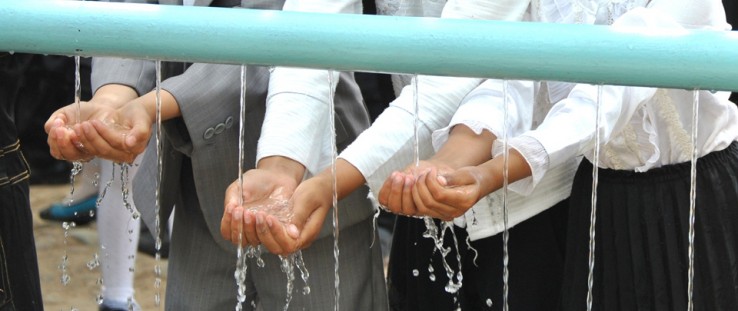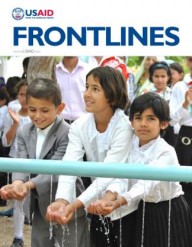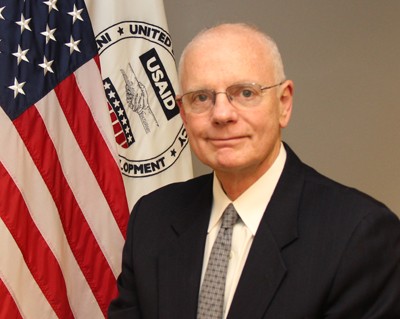 Children experience clean water running through their hands.
USAID
Children experience clean water running through their hands.
USAID
 Children experience clean water running through their hands.
USAID
Children experience clean water running through their hands.
USAID
Water is essential for life. Humans need water to drink, to bathe and to grow food. However, more than 780 million people—about two and a half times the population of the United States—lack access to safe drinking water, and 2.5 billion people lack access to sanitation worldwide. Most of these people live in developing countries, where the consequences of unsafe water are devastating. In just one day, more than 1,900 children die as a result of diarrheal diseases associated with poor quality water, lack of sanitation facilities and inadequate supplies of water for hygiene.
Water is also essential to developing economies and food security. The world’s growing population and rising food demands are predicted to increase the amount of water used in agriculture production, which already constitutes 70 percent of the demand on freshwater resources. Stressors such as climate change and conflict continue to increase pressure on our limited water resources. It is projected that by 2025, two-thirds of the world’s population could face constant severe water shortages.
Achieving reliable access to water, or water security, is one of the greatest development challenges confronting the world today. It cuts across nearly every aspect of USAID’s work, from improving health, producing food and energy, adapting to climate change and maintaining political stability.
In the coming weeks, USAID plans to launch a new Water and Development Strategy that will steer USAID’s water programs toward the key themes that are consistent with two of the most important needs we have for water: health and food. It is our hope that improvements in access to water supply, sanitation and hygiene (WASH) services, and sound management and use of water for food security will save lives and enhance development. Moving forward with this strategy, we are committed to focusing our resources in a more limited number of countries where need is the greatest and where our assistance in the water sector can achieve maximum impact.
WASH interventions have enormous potential to produce both economic and health benefits. Time saved in fetching water can be used for more productive activities, especially for women and girls who, on average, walk 6 kilometers per day carrying 20 liters of water. Cleaner water and better hygienic practices lead to reduced incidence of waterborne diseases and a more productive society. The cost of health care is reduced. It has been estimated that the economic benefits of WASH activities range from between $5 and $46 per $1 invested.
One project that embodies USAID’s work in the water and sanitation sector is the WASH for Life Project in Kenya. Here, 8 million people in urban areas do not have access to simple, hygienic latrines and are forced to use communal pit latrines sometimes shared with hundreds of other people. A grant provided through USAID’s WASH for Life project allowed a company called Sanergy to build and franchise a network of 60 low-cost pit latrines to slum residents. Within five years, the 3-year-old company plans to expand to more than 3,000 centers reaching 600,000 slum dwellers.
In Somalia, the School Environment and Education Development for Somalia (SEEDS) project provided access to water, sanitation and hygiene facilities on school grounds, promoted hygiene education and trained teachers and government officials. When the project ended in 2012, results included: 359 latrines constructed and another 189 rehabilitated in 114 schools; 213 hand-washing facilities installed in 90 schools and five water points completed. All told, more than 150,000 people in these communities benefitted, and student enrollment increased by more than 32,000. It’s important to note that of those students, 12,666 were girls whose parents would only allow them to attend school with the kind of private, girls-only latrines built as part of this project.
USAID is also promoting more efficient use of rainfall and groundwater, and more effective management of irrigation. In Nepal, 66 percent of households experience food shortages each year. USAID’s Nepal Economic Agriculture and Trade (NEAT) program is helping cut input costs and boost crop productivity by installing and rehabilitating irrigation systems and training local technicians to maintain them. That, along with parallel efforts that are part of this project, is expected to directly benefit over 300,000 Nepalese and indirectly impact millions in the country by improving the business environment, facilitating trade flows and strengthening fiscal policy.
In this issue of FrontLines, you will learn about some other water programs already underway that align with the new strategy, including the Further Advancing the Blue Revolution Initiative, a regional USAID project in sub-Saharan Africa to reduce water system losses that can be as high as 75 percent in some African cities. We also examine the results of projects to increase the availability of clean, reliable and affordable water in Nigeria, Kenya, Tajikistan, Jordan, Gaza and Indonesia, as well as efforts to improve wastewater treatment in the West Bank that benefit both Palestinians and Israelis. You can also read about USAID’s work to promote zero-till agriculture in India, and renovate irrigation networks in Kyrgyzstan.
You’ll learn about the intersection of USAID’s water and sanitation programs and the Agency’s humanitarian assistance. In the Democratic Republic of Congo, we are working to extend the water system to the city of Goma’s most disadvantaged population, and in northern Jordan, we are helping to conserve water in areas where a rapid influx of Syrian refugees is straining already scarce water resources.
In the last decade, USAID has delivered safe water and sanitation to more than 50 million people, while assisting governments and private firms to plan, manage and distribute water more equitably and affordably. The lessons we have learned over the decades are informing the way we will tackle the ongoing and evolving issues of water in the 21st century.
Looking ahead, our new strategy will provide better focus to our water and sanitation programs, putting us in a great position to make a major difference in the lives of millions of men, women and children in the developing world.










Comment
Make a general inquiry or suggest an improvement.